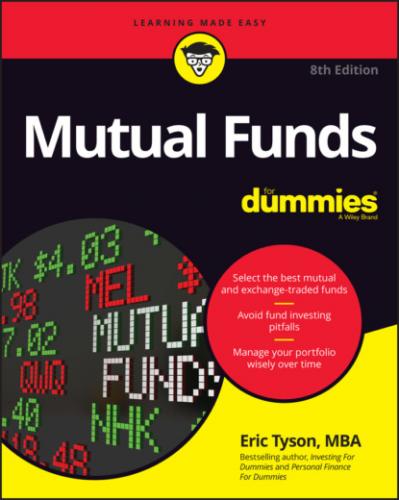Chapter 5
Exchange-Traded Funds and Other Fund Lookalikes
IN THIS CHAPTER
The hallmarks of the investment and economic system are constant change, innovation, and choice. Index mutual funds, which track a particular market index (see Chapter 10) and the best of which feature low costs, have been around for decades.
The best exchange-traded funds (ETFs) represent a twist on index funds — ETFs trade like stocks do and offer some potential advantages over funds. However, some cheerleaders pitching ETFs gloss over drawbacks to ETFs and fail to disclose their agenda in promoting ETFs.
Some other fund wannabes compete for your investment dollars, too. This chapter offers the straight scoop on these alternatives.
Understanding Exchange-Traded Funds
For many years after their introduction in the 1970s, index mutual funds got little respect and money. Various pundits and those folks with a vested financial interest in protecting the status quo, such as firms charging high fees for money management, heaped criticism on index funds. (As I explain in Chapter 13, index funds replicate and track the performance of a particular market index, such as the Standard & Poor’s 500 index of 500 large-company U.S. stocks.) Critics argued that index funds would produce subpar returns. Investors who’ve used index funds have been quite happy to experience their funds typically outperforming about 70+ percent of the actively managed funds over extended time periods.
In recent years, increasing numbers of financial firms have developed exchange-traded funds (ETFs). Most ETFs are, essentially, index funds with one major difference: They trade like stocks on a stock exchange. The first ETF was created and traded on the American Stock Exchange in 1993 and tracked the Standard & Poor’s 500 index. Now thousands of ETFs trade, comprising about $7 trillion — a large sum indeed — which is about 26 percent of the total invested in mutual funds.
Before you decide to invest in ETFs, take a moment to read this section. It explains the advantages and disadvantages of investing in ETFs and helps you wade through the many ETFs to find the best ones for you.
Understanding ETF advantages
Like index funds, the promise of the best ETFs is low management fees. I say “promise” because when evaluating ETFs, you must remember that the companies creating and selling ETFs, which are mostly large Wall Street investment firms, are doing it to make a healthy profit for their firms. Although the best index funds charge annual fees of about 0.1 percent (and some even less), the vast majority of ETFs actually charge fees much greater than that.
I compare the best index funds with the best ETFs (which do have low expense ratios) in the section “Identifying the best ETFs,” later in this chapter.
In addition to possible slightly lower expenses, the best ETFs have one possible additional advantage over traditional index funds: Because ETFs may not be forced to redeem shares to cash and recognize taxable gains (which can happen with an index fund), they may be tax friendlier for nonretirement account investors. (Note: ETFs do have to sometimes sell and buy new holdings as adjustments are made to the underlying index that an ETF tracks.)
If you can’t meet the minimum investment amounts for index funds (which are typically several thousand dollars), you may be happy to hear that you face no minimums when buying an ETF. However, you must factor in the brokerage costs to buy and sell ETF shares through your favorite brokerage firm, and be sure that those fees don’t greatly boost your costs. Many leading brokers have eliminated brokerage commissions on many ETFs, so be sure to comparison shop (see my short list of recommended firms in Chapter 9). Because of the brokerage costs, ETFs aren’t a good vehicle for investors who seek to make regular monthly investments unless you can do this without paying a brokerage fee.
Eyeing ETF drawbacks
Meanwhile, some of the drawbacks to ETFs include the following:
Three-day settlement waiting period: A possible disadvantage with ETFs is that, like stocks, you have a three-day settlement process when selling shares. So, for example, if you sell shares of an ETF on Monday, you won’t have the proceeds to invest into a regular mutual fund until Thursday. (This delay won’t be a problem if you’re going back into another ETF or buying a stock, because a purchase order placed on Monday for a new investment won’t settle until Thursday.) If you’re out of the market for several days, the market price can move significantly higher, wiping out any supposed savings from a low-expense ratio.
Potential fees for dividend and capital gain reinvestments: With a traditional mutual fund, you can, without cost, reinvest dividend and capital gains distributions into more shares of the fund. However, with an ETF, you may have to pay for this service through some brokers, or it may not be available through the broker that you use.
Disproportionate amount of particular stocks: One problem with a number of the indexes that ETFs track (and with some index funds) is that certain stocks make up a disproportionately large share of a particular index. This is especially true of industry-focused ETFs. This is also true for some broader market ETFs like those that track the Standard & Poor’s 500 index because each of the 500 stocks’ composition in the index is driven by each stock’s portion of total market value. Check out Table 5-1, which shows the composition of the index at the end of 1999. This list mostly represented a who’s who of many overpriced technology stocks that subsequently got clobbered in the early 2000s bear market.
Invested segments too narrow: Many of the newer ETFs invest in narrow segments, such as one specific industry or one foreign country. As with sector mutual funds (see Chapter 13), such
